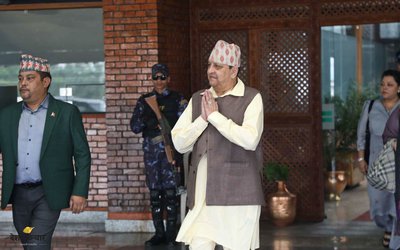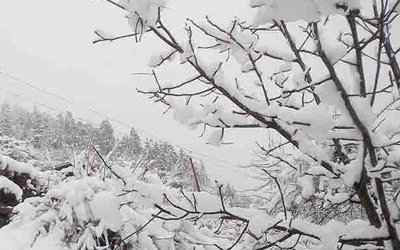More on News


DR. HARI KRISHNA UPADHYAYA earned his Ph.D in Agricultural Economics in 1988 from University of the Philippines at Los Banos (UPLB) with outstanding academic performance. In 1991, he initiated and led the establishment of the Centre for Environmental and Agricultural Policy Research, Extension and Development (CEAPRED) – a leading national NGO engaged in rural livelihood enhancement in Nepal. Dr. Upadhyaya, a former member of the National Planning Commission, chose to stay back in Nepal after his postgraduate studies so that he could do something meaningful towards reducing rural poverty of small and marginal farmers by creating and expanding agro-based income generating opportunities at the local level, such as commercial off-season vegetable production in which Nepal’s hilly areas have had natural ecological advantage. His perseverance, dedication and commitment eventually paid off. Nepal has begun to commercialize its subsistence-based agriculture. CEAPRED, which started with a small program involving 1300 households launched in the eastern part of Nepal in 1991, is now working with 120,000 families in 42 districts. With support from his organization, large numbers of rural and marginal farmers are seeing drastic changes in their livelihoods as they turned to off season, market based vegetables and vegetable seed production. As CEAPRED celebrated two decades of its establishment, Dr. Upadhyaya spoke to KESHAB POUDEL on various aspects of CEAPRED’s work. Excerpts:
What do you say of the two decades of CEAPRED in Nepal’s agricultural sector?
Well, thanks to all those who supported us, CEAPRED has been able to establish itself as a national developmental NGO of Nepal. In fact, it is the first non-governmental organization in the country to work in the agriculture sector since its establishment in 1991.
In which areas is CEAPRED working?
CEAPRED has consciously and consistently focused on sustainable poverty reduction and enhancement of food security and livelihoods of the poor, disadvantaged and deprived families including small and marginal farmers of rural Nepal.
What is the major difference of your approach compared to that of others?
CEAPRED’S approach to poverty reduction consists of promotion of new and better economic and livelihood opportunities at the local level and linking these opportunities to potential markets, both within and outside the country. Some examples of CEAPRED’s initiatives, which have been most widely recognized and referred to, include commercial off-season vegetable production program launched in the early 90s and commercial vegetable seed production currently in operation in several districts of Nepal.
Why did you choose the vegetable seeds?
In remote and inaccessible areas, commercial production of bulky and perishable commodities, such as fresh vegetables, is not a feasible strategy for increasing household income and food security due to the lack of market access. But, commercial production of low-volume, high-value commodities, such as vegetable seed is. Unlike fresh vegetables, vegetable seeds are high-value low volume commodities and can be stored locally without any significant quality loss.
Could you explain the CEAPRED program approach?
CEAPRED follows a three-pronged program approach consisting of social mobilization, capacity development and local institution building. Almost all the projects designed and implemented by CEAPRED have followed this approach. CEAPRED has already promoted some 164 primary cooperatives of various types, which include 11 multipurpose co-operatives, 35 production cooperatives, 72 marketing co-operatives and 46 savings and credit co-operatives. District unions have been established in 13 districts. In addition, a number of new cooperatives, including district and central unions, are currently in the process of formation.
What is CEAPRED’s microfinance strategy like?
Despite the growth of a number of financial institutions, a large proportion of the rural people in general and rural poor in particular are still deprived of access to formal financial services. In rural Nepal, where accessibility is constrained, population is sparse and off-farm trade and micro-enterprises are limited, external models, such as Grameen Banks, do not seem to work. Mobilization and organization of clients and delivery of micro-finance prove costly. Due to poor marketing networks and infrastructure, the extent to which borrowers can generate quick returns and therefore, repay loans on weekly, is very limited. In this context, saving and credit models, which are internal to the community, prove more effective, efficient and sustainable. CEAPRED has adopted this model as a means to expanding financial services in rural areas. A major additional advantage of this model is that it serves to link microfinance with technology and other business development services at the organizational level.
How can farmers be made more productive?
First of all, infrastructure development should be given top priority. Alongside, new and more productive technologies should be made available to the farmers. I said “alongside’ because it should not take long after building roads for farmers to access productive technologies as in the case of farmers along the Dharan-Basantpur highway who benefited from off-season vegetable production technologies nearly two decades after the highway was built.
What in your experience makes the difference?
Twenty years ago, we came up with a particular vision or philosophy for agriculture. It was not just an approach to agricultural development. It was like a new paradigm - a paradigm that was fit for Nepal’s unique geo-physical and ecological context.
Why do you think the approach was suitable for us?
Nepal, fortunately or unfortunately, is surrounded by two big countries, namely, India and China. Economically and socially, India comes to the forefront. There is a very nominal possibility for us to compete with India in food grain production. India is far ahead of us in terms of infrastructure development, subsidies and economies of scale, which reduce the cost of production and increase the competitiveness of Indian farmers over Nepali farmers. However, we can be better off in one condition. If we can plan commodity production by taking into consideration our ecological or natural niches, which I often refer to as our “natural ecological capital”, Indian products cannot compete with us on such niche commodities. If we are able to tap the ecological diversity and produce commodities accordingly, we can easily access markets, including the border markets.
Does India not have such ecological zones?
India does have pocket zones like Kashmir or Himanchal, which can produce what our hills can produce. But India is a huge market. With the population of a billion, India’s vegetable market is so huge. If we target to cater to a small portion of Indian vegetable market, it is going to change our rural economy. In economics term, we seem to face a perfectly elastic or horizontal demand curve with India, meaning almost everything that we produce can be consumed by the market without changing prices.
How viable is it for producers to think in this light?
Theoretically, producers and suppliers who face a perfectly elastic demand are not in the most advantageous positions. However, for small production such as ours, the price is always given and our supply will not change the price. Compared with the size of total demand, our supply will be nominal. Even in the present context of WTO, off season vegetables will be most advantageous commodities to benefit the farmers. We cannot sustainably compete with India in other normal season agricultural products because of differences in subsidy regime, level of infrastructure and the scale of production.
Do people know about the contribution CEAPRED has made?
Frankly speaking, we have never made any conscious effort ourselves to do the marketing for our organization. We have relied on others to do that for us. And it has worked to some extent. We believe that our work and the impact it has made on the lives of the poor should speak for us. The paradigm that we experimented, I am proud to say, has worked. Nobody needs to talk and go for mass sensitization for off season vegetables now. There is enough evidence on the ground as to what works and what does not.
The idea is good for areas where there is easy access to market but what about the remote areas where you cannot sell fresh vegetables? We think commodities that are non-perishable, high-value and low-volume will be most suitable in remote areas. One example is vegetable seeds. Our experience of last six years on vegetable seeds has shown that this works.
How dependent is CEAPRED upon donors?
Whether one likes it or not, I have to accept the fact that we are largely donor dependent, like other NGOs of the country. But we have never compromised on our priority and competitive strengths. We accept projects which are complimentary or at least do not override our goals and our internal expertise. We have also tried to stick to our approach and to our target groups, which are poor, marginalized and disadvantaged people.
How do you assess the current level of economic transformation? Almost every economy in the world is agrarian in its early stage of development. Agriculture has been a major sector contributing to industrialization of most economies that are developed now. Every country has to go through the process of structural transformation from agriculture to non-agriculture. Nepal is no exception. Nepal is also in the process of structural transformation. At the first stage Nepal’s economy was subsistence based and nobody sold milk and vegetables. In the second stage, there is visible move towards commercialization. The off season vegetables, dairy and meat and meat products are products of the second stage. The next stage is one of specialization and shift towards industrialization, and agro-industries or agro-processing will provide a smooth link to this shift.


